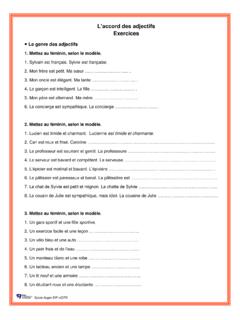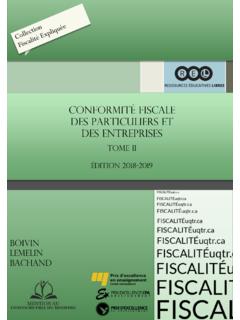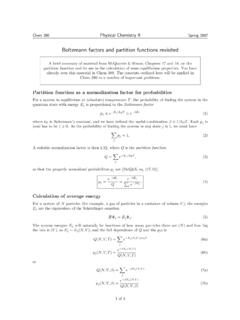Transcription of Spartan Physical Chemistry Edition - Université du Québec
1 Spartan Physical Chemistry EditionTutorial and ActivitiesWAVEFUNCTIONW avefunction, Von Karman Avenue, Suite 370 Irvine, CA 92612 , Inc., Japan Branch Offi ce3-5-2, Kouji-machi, Suite 608 Chiyoda-ku, Tokyo, Japan 2005 by Wavefunction, rights reserved in all countries. No part of this book may be reproduced in any form or by any electronic or mechanical means including information storage and retrieval systems without permission in writing from the publisher, except by a reviewer who may quote brief passages in a 1-890661-31-7 Printed in the United States of AmericaPrefaceIPrefaceOver the last decade, molecular modeling has evolved from a specialized research tool of limited availability to an important means with which to explore Chemistry .
2 The obvious catalyst has been the explosion in computer technology. Today s personal computers are more powerful than yesterday s supercomputers. Computer-based models are now routinely able to supply quantitative information about the structures, stabilities and reactivities of molecules. Computer graphics has made modeling easy to learn and easy to do. Molecular modeling has an increasingly significant role in the teaching of Chemistry . It offers a natural companion to both traditional lecture/textbook and laboratory approaches.
3 Modeling, like lectures and textbooks, not only facilitates communication of both concepts and content, but also allows for the discovery of new Chemistry , very much in the same way as a laboratory. Molecular models offer a rich source of visual and quantitative information. They can be used by instructors to enhance and liven traditional lectures and classroom discussions, and by students on both personal and school computers to learn and explore Chemistry . These opportunities prompted us to develop a version of the Spartan molecular modeling program for use by students in their study of Chemistry , in particular, organic Chemistry .
4 We now follow this with a second Student version of Spartan that is appropriate for the Physical Chemistry curriculum. It extends the capabilities of the earlier Student version with density functional and M ller-Plesset models as well as larger basis sets to more accurately explore the limits of these models. While size limits have been placed on the methods and some of the more advanced features of the full research version of Spartan have been omitted, this version offers students access to state-of-the-art modeling guide is intended to help students and faculty get started.
5 Following a brief introduction, a series of tutorials provide fundamental protocols for building molecules, specifying calculations and analyzing results. A series of essays follows the tutorials. These describe the IIorigins of the molecular mechanics and quantum chemical methods available in Spartan and assess their ability to calculate important chemical quantities. They also provide guidelines for determining equilibrium and transition-state geometries and for using Spartan s graphical analysis tools.
6 Next is a series of hands-on problems that focus primarily on Chemistry and not on the molecular models or modeling techniques. These span a variety of topics covered in the Physical Chemistry curriculum, and complement the modeling problems found in the recent textbook Physical Chemistry by Thomas Engle and Philip Reid of the University of Washington (Benjamin Cummings, San Francisco, CA, 2006). Some of these problems require only a few minutes to complete while others may demand several hours. The guide concludes with a glossary of terms and acronyms common to molecular modeling and designation of units for the quantities arising from the guide does not provide detailed information about the workings of the functions under Spartan s menus.
7 This information is included as part of the on-line User s Guide available under the Help development of Spartan for use in teaching Chemistry has been influenced by many individuals, including Wim Buijs (of DSM Corporation and of the Technical University of Delft), Richard Johnson and Barbara Hopkins (of the University of New Hampshire), Tom Gardner (of Boston Scientific), Alan Shusterman (of Reed College), Philip Bays (of St. Mary s College), and Thomas Engle (of the University of Washington).
8 TOCIIIT able of : The Organic Model Tetrafl uoride: The Inorganic Model Spectrum of and Pyridine: Electrostatic Potential vs. Strong Rotation in Energy One Dimensional Energy Many Dimensional Energy The Schr dinger Hartree-Fock Molecular Orbital Correlated Semi-Empirical Molecular Orbital Molecular Mechanics a Theoretical In Terms of In Terms of Energies and Thermodynamic and Kinetic and Verifying Equilibrium and Transition- State Equilibrium Transition-State Reactions Without
9 Transition Calculations Using Approximate and Molecular Orbital Atomic Orbitals and Chemical Molecular Orbitals of Singlet Densities: Sizes and Shapes of Space-Filling Electron Density Bond Density Potential Maps: Charge Ionization Potential Maps and LUMO Maps: Electrophilic and Nucleophilic Local Ionization Potential Maps and Electrophilic LUMO Maps and Nucleophilic Hands-On and Bonding and Intermolecular Moments and and and UV/Visible Terms and A1 Section AIntroductionWhy does computer-based molecular modeling play an important role in chemical research?
10 Is it that, at the same time the cost of experimental laboratory science has skyrocketed, the cost of modeling has sharply decreased? Is it that computational methods, and the software and hardware needed to implement these methods, have matured to the point where useful results can be obtained for real systems in a practical time period? Could it be that the famous quote,The underlying Physical laws necessary for the mathematical theory of a large part of physics and the whole of Chemistry are thus completely known, and the diffi culty is only that the exact application of these laws leads to equations much too complicated to be Dirac 1902-1984made by one of the founders of quantum mechanics at a time when that science was still in its infancy, is now only half true?



















